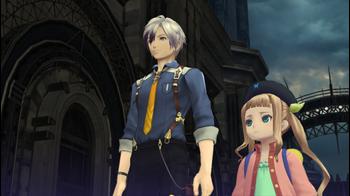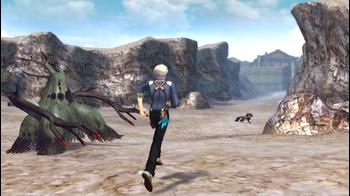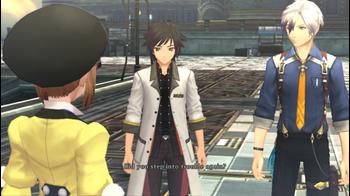
Tales of Xillia 2 Review
Western markets have seen plenty of the Tales series in the last several years, with the remaster compilation for Tales of Symphonia having released only six months ago. A few years after its Japanese launch, Tales of Xillia 2 is the most recent entry in this long-standing franchise and a direct sequel to 2013’s Tales of Xillia. Bandai Namco changed up a formula a bit with several tweaks to gameplay and structure, but is that enough to make the sequel worthwhile?
Taking place a year after the original, we now follow the storyline of Ludger Kresnik, a silent protagonist who finds himself in the middle of a worldwide conflict centered around a mysterious young girl, Elle, and her unusual pocketwatch. The old cast joins up again too, so no worries, your favorite (and least favorite) party characters are once again playable.
The familiar fast paced combo-based battle system makes a return, complete with the linking mechanics introduced in Tales of Xillia. Those who have played the original title should immediately feel comfortable here, as the base battle mechanics are left largely the same. Battles are initiated by encountering enemy icons on the field, bringing the party to the field arena. Characters move around in real time, using a variety of attacks and ‘arte’ abilities (the Tales series’ moniker for special attacks) to take out foes.
The combo length dictating Assault Counter (AC) system and Technical Points (TP) used to perform artes both return, while all of the character Linking systems are also back. As is typical for the franchise, each character is fully playable, each one boasting their own combat styles and abilities. Linked characters can provide support in different ways, such as breaking enemy guard or recovering from being knocked down. Knowing which links to use on which enemies can definitely make things easier, especially on the higher difficulties.
Ludger, however, has the unique quirk of being able to wield three weapon types, and he can switch between them on the fly in battle. Each weapon type also carries its own set of arte abilities, so Ludger’s attack arsenal is quite extensive. Different link partners are better suited for certain weapon types, and enemies may be vulnerable to one weapon over the other. In addition, Tales of Xillia 2 brings emphasis to the Weakness system, where effective elements can be used to more easily rack up combos and damage.
These combat tweaks add just enough sophistication to combat to spice up how to approach combos without being obtuse or overbearing. While the standard difficulty mode may be a bit simple for regular mobs, the game’s difficulty can be changed at any time, allowing the player to ramp up the challenge if they choose. Battles load quickly from exploration, but sometimes encounter frame rate issues when numerous effects occur simultaneously.
Where Tales of Xillia 2 really differs from the original is how the progression of the game is structured. Early on, Ludger finds himself in a large amount of debt, and he must pay back the loan regularly over time to open up more locations and to further the plot line. In short, the debt system works as gateway throughout the entirety of the game, and effectively blocks progress at points until you are able to make a payment.
The game is divided into chapters, and before each chapter can begin, the player has to dump some gald (Tales’ currency) towards the outstanding debt amount. What happens if you don’t have enough? Well, that’s where you can take on requests from the quest board, which has jobs such as collecting loot or eliminating a certain number of enemies – pretty typical tasks for this sort of thing.
The debt and quest structure does break pace a fair amount. Sometimes it comes across quite rigid, as everything will halt until you can meet the next payment threshold. However, usually hunting an elite monster or turning in some loot items is enough to pay the bill to continue. I never found it to be too intrusive as I usually had plenty of money to spare to keep progressing readily, but it depends on how much time players spend off the main storyline path.
While the battle system is fast and fun, other aspects still suffer many of the same issues found in the original game. Most of the locations you visit are identical and unchanged to those in Tales of Xillia, including the numerous field/path areas, which themselves are practically copy-and-pasted from each other.
As if to add insult to that particular injury, oftentimes you'll find yourself needing to backtrack across the same areas more than once. Dungeon areas all follow straightforward paths as well, with little to no room for exploration or discovery. There are no puzzles to break up the pace, no mazes to navigate. Getting through the game entails going from point A to point B, battling enemies along the way and clicking X on loot spots and chests. Only a small number of locations are actually ‘new’ in Tales of Xillia 2. That's a disappointment.
Despite the missed opportunity to fix one of the bigger issues of its predecessor, Tales of Xillia 2 does improve over the original in a few other ways. No longer do you need to raise shop levels as they have been replaced with more ordinary shop progression. Equipment synthesis also makes a return, with elemental weapons available to craft – which, considering the Weakness system, are very useful to obtain.
The post-game content is also quite decently improved. There are many elite monsters around which act as extra boss-like encounters, as well as a full-fledged arena and a bonus post-game dungeon. There is high-level equipment to craft and even some poker if you want to take a break from battling for a while. The classic Tales cameo battle also returns, something absent from Tales of Xillia.
As for the narrative, Tales of Xillia 2 utilizes a silent protagonist this time around, similar in vein to the Persona or Ys series. However, considering the largely cinematic style of Tales cutscenes and the classic banter-filled skits, having a protagonist grunt his way through the story and in character interactions never quite felt right to me.
The game tries to work with this by introducing a choice system, where Ludger can make dialogue decisions during cutscenes. The lack of any voiced responses here often lends itself to more stilted conversations and a wooden dialogue flow, as many things have to lead in a response from the player that ultimately often has only a minor effect on the scene. The saving grace here comes from the voice cast, with the performances of the core cast generally well done.
There are other niggling issues with the story as well. While Ludger and Elle are clearly the centerpiece of the story, many of the prior Xillia characters feel superficially attached to events, some to the point of feeling like they needn't be a part of the cast at all. The game includes ‘character quests’ for these party members in order to flesh them out, but only a few of these actually incorporate well into the plot line. As for the plot itself, it takes some time for things to get rolling. For a large portion of the game, the actual conflict at hand is largely obscure and nebulous. The pace at which events unfold is sluggish and in places struggled to keep my attention. Thankfully, satisfying combat helps to offset that.
Those who enjoy action battle systems like in Tales of Xillia will enjoy their time with Xillia 2 in that regard thanks to a solidly-evolved set of battle mechanics. With that said, the widespread reuse of field and dungeon areas represents a missed opportunity, and changes to gameplay progression and plot structure might end up leaving some cold.



